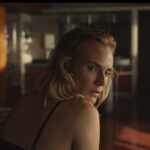While watching the opening moments of The Snare, it was easy to see that the tone of the film was going to be grim. Beginning on a completely black screen with shrill ominous chords playing in the background, it then cuts to several shots of an overgrown and neglected cemetery strewn with grey tombstones. Then it transitions to a shot of a big black spider on a branch before ending on a final sequence of shots showing a dead and decaying rabbit infested with maggots and flies. Yeah, I felt this was a pretty good indication of a rather bleak story.
The story in question actually centers on a sullen and morbid young woman named Alice. She lives with her father, with whom she appears to have, at best, an awkward relationship. For the weekend she will be joining her friend Lizzy and her boyfriend Carl on a trip to a coastal town. Lizzy’s dad is an estate agent and she discreetly snagged the keys to a flat/apartment on the top floor of a secluded vacation property. It’s the off-season and winter is just around the corner, so there is nobody around to bother them or in turn be bothered by them.
They gather provisions at a local shop then return to settle in and make themselves at home for the weekend. After a night of merry-making, they awaken to find that someone has closed up the building for the winter. All of the elevators are shut down and the stairway entrances are all locked, leaving no way to leave the floor they are on, let alone the building. Compound their situation with a lack of landline phone service and no mobile reception; it’s unlikely they’ll soon be leaving…especially since nobody even knows where they are.
It doesn’t take long before they are at each others throats like rats in a cage, creating an environment that causes Alice’s already fragile psyche to crack. Her reality begins to blur between nightmarish visions and reality. As days continue to pass with no likelihood of release from their confinement, they all spiral further into hopelessness and desperation.
The Snare serves as C.A. Cooper’s feature length writing and directing debut. In this film he creates a simple but effective story steeped heavily in paranoia, smothered hope, and madness. The element of Alice’s macabre dreams and visions was very Kubrickian in nature, echoing shades of The Shining. This coupled with the scenes of Alice writing in her diary helped to develop a character who is not only emotionally unstable but also morbidly fixated on death. Add this to an already tense situation, and the secure and benign confines of a holiday flat can become hellish prison.
The most notable performance would of course have to be Eaoifa Forward in the role of Alice. Forward effectively and convincingly conveys Alice’s emotional turmoil and awkwardness with appropriate subtlety. A great deal of her expressiveness comes through by way of her eyes. She has a way of pulling you in, and then dragging down into her character psychological downward spiral. Dan Paton and Rachel Warren are solid in their performances as Carl and Lizzy. Paton does a good job of making Carl a pompous, self centered cad, who over the course of the film becomes rather volatile. Warren is equally effective in portraying Lizzy as a carefree girl who just wants to enjoy life, who transitions into hopelessness and bitterness as a result of the group’s circumstances. In his limited screen time as Alice’s father, Stuart Nurse made it obvious that his character has an unnatural, even inappropriate attachment to his daughter.
The film was shot in such a way that it lent a great deal to the sense of both isolation and claustrophobia. Exterior shots tended to show wide open and rather desolate and unpopulated areas. Interior shots tended to create a sense of very tight spaces, often uncomfortably so. Utilizing close quarters vantage points from within cupboard or closets were particularly effective in that regard. The cast are also often featured in closeup shots thus negating the concept of any perceived personal space. While such a confined setting could prove problematic in some cases, this story benefited greatly from its spatial limitation. The first filmmaker that comes to mind when considering successful films shot on spatially limited sets would be Alfred Hitchcock (Dial M for Murder, Rope, Rear Window). Being able to create a truly creepy film within such a confined area is not nearly as easy as one would think, and thus serves as a testament to the cast and crew for being able to do so.
Practical effects on this film were well done and some were just revolting. Gore effects were very limited but still well done. And the make-up effects applied to the three confined cast members was extremely effective in showing their worsening condition over the duration of their entrapment. The one practical effect in the movie that was most disturbing is also the one that was most…well, REAL. I won’t go into much detail, all I will say is…maggots, ugh. One final piece that proved to be just as important as any of the characters, was Tim Johnson’s musical score. It’s absolutely chilling and perfectly accentuates the fear and tension of the film as it truly gets under your skin.
As far as debuts go, I would have to say C.A Cooper is off to a very good start. For anyone who enjoys creepy, dreary and psychological horror, this is one I recommend. I will offer one caveat (that means warning to you and me Rusty), you may want to see it on an empty stomach and forego any movie time nibbles. The Snare opens in theaters January 6th of 2017…if you should be lucky enough to be near a theater that’s showing it.
7.5 / 10














